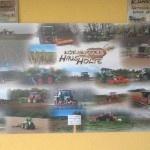Farm description
The roots of Mr. Liedmann lie in the ecologic movement. Being a carpenter, 1987 he just started organic farming in order to do something practically in terms of ecology. Insofar ecology and sustainability of organic farming is something that concerns him to date. The source of his knowledge is thorough observations and experimenting. Since 2005 he recognizes the impact of climate change in his plant production; especially the precipitation patterns has massively changed since then but also a rise in mean temperatures can be observed.
The cattle loose Bioland farm Kornkammer Haus Holte has in an average annual temperature of 8.9⁰C and a mean annual rainfall of 750-890 mm. On a total of nearly 250 ha with mainly loess soil he cultivates cereals (143 ha), red clover and legumes (54 ha), potatoes (32 ha), permanent grassland (15 ha) and hedges (6 ha).
Climate friendly practices applied
- Improved on-farm nutrient management
First cut of grass-clover is shipped to nearby biogas fermentation plant, which produces electricity and heat energy (replacement of fossil fuels). Liquid and solid residues are brought back to croplands. Furthermore, N2O emissions from mulching are avoided and N fixation of forage legumes is increased.composting of on-farm residues.
- Optimised crop rotations with legumes
Introduction of grain and forage legumes
The farm introduced leguminous crops. Red clover is produced for the biogas plant instead of cultivating maize on 39 ha. Additionally, grain legumes (field beans) were cultivated instead of winter wheat. By this, the area cultivated with leguminous crops increased by 23%.
- Optimised tillage systems
No-tillage and reduced tillage systems
Red clover, winter wheat and spelt are cultivated ploughless. Additionally, a ploughless cultivation of potato was tested on 32 ha. Last, the farmer reduced the depth of tillage from 20-25 cm to 5-10 cm at the oat fields.
Reducing tillage helps to reduce fossil fuel consumption.
- Agroforestry
Hedgerows and tree strips along agricultural fields
The farm planted around 3 ha of hedges and tree strips on their fields. Along with the already existing diverse hedges and trees, around 6 ha are used as boundaries for the arable fields.
Trees and hedges help to sequester atmospheric carbon into plant biomass and soils. Therefore, they function as a carbon sink.
